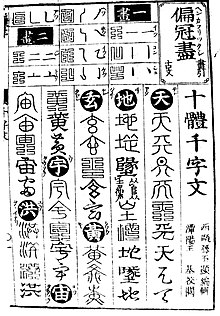
Back Clásicu de mil caráuteres AST Clàssic de mil caràcters Catalan Chiĕng-cê-ùng CDO Text o tisíci znacích Czech Tausend-Zeichen-Klassiker German Clásico de mil caracteres Spanish Classique des mille caractères French Chhiên-sṳ-vùn HAK Qian Zi Wen Italian 千字文 Japanese
| Thousand Character Classic | |||||||||||||||||||||||||||||||||||||
|---|---|---|---|---|---|---|---|---|---|---|---|---|---|---|---|---|---|---|---|---|---|---|---|---|---|---|---|---|---|---|---|---|---|---|---|---|---|
 A calligraphic work titled An Authentic "Thousand Character Classic", Song dynasty | |||||||||||||||||||||||||||||||||||||
| Chinese name | |||||||||||||||||||||||||||||||||||||
| Chinese | 千字文 | ||||||||||||||||||||||||||||||||||||
| Hanyu Pinyin | Qiānzì wén | ||||||||||||||||||||||||||||||||||||
| |||||||||||||||||||||||||||||||||||||
| Vietnamese name | |||||||||||||||||||||||||||||||||||||
| Vietnamese alphabet | Thiên tự văn | ||||||||||||||||||||||||||||||||||||
| Chữ Hán | 千字文 | ||||||||||||||||||||||||||||||||||||
| Korean name | |||||||||||||||||||||||||||||||||||||
| Hangul | 천자문 | ||||||||||||||||||||||||||||||||||||
| Hanja | 千字文 | ||||||||||||||||||||||||||||||||||||
| |||||||||||||||||||||||||||||||||||||
| Japanese name | |||||||||||||||||||||||||||||||||||||
| Kanji | 千字文 | ||||||||||||||||||||||||||||||||||||
| |||||||||||||||||||||||||||||||||||||

The Thousand Character Classic (Chinese: 千字文; pinyin: Qiānzì wén), also known as the Thousand Character Text, is a Chinese poem that has been used as a primer for teaching Chinese characters to children from the sixth century onward. It contains exactly one thousand characters, each used only once, arranged into 250 lines of four characters apiece and grouped into four line rhyming stanzas to facilitate easy memorization. It is sung, akin to alphabet songs for phonetic writing systems. Along with the Three Character Classic and the Hundred Family Surnames, it formed the basis of traditional literacy training in the Sinosphere.
The first line is Tian di xuan huang (traditional Chinese: 天地玄黃; simplified Chinese: 天地玄黄; pinyin: Tiāndì xuán huáng; Jyutping: Tin1 dei6 jyun4 wong4; lit. 'Heaven earth dark yellow') and the last line, Yan zai hu ye (焉哉乎也; Yān zāi hū yě; Yin1 zoi1 fu4 jaa5) explains the use of the grammatical particles yan, zai, hu, and ye.[1]
- ^ Paar (1963), p. 7, 36.